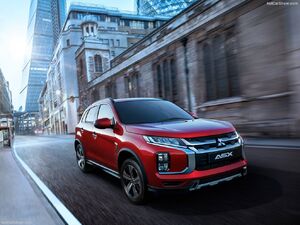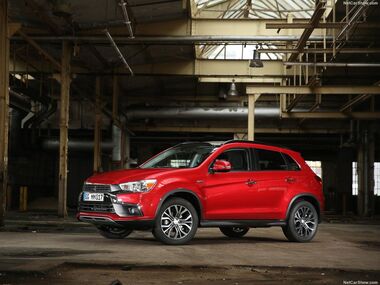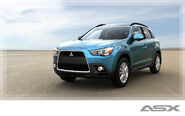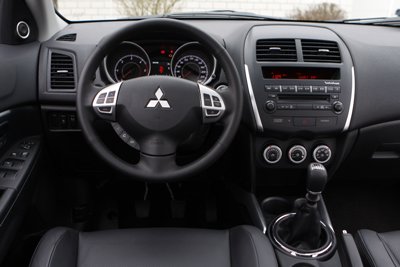
| |
| Mitsubishi RVR | |
|---|---|
| Mitsubishi | |
| aka | ASX Outlander Sport (US) |
| Production | 1991–2002 2010–present |
| Class | Subcompact crossover SUV |
| Body Style | 5-door SUV |
| Length | 4,295 mm (169.1 in) |
| Width | 1,770 mm (69.7 in) |
| Height | 1,625 mm (64.0 in)
64.2 in (1,631 mm) |
| Wheelbase | 2,670 mm (105.1 in) |
| Weight | 1,770 mm (69.7 in) |
| Transmission | 5/6-speed manual
6-speed automatic 6-speed INVECS-III CVT |
| Engine | Petrol:
1.6 L 4A92 I4 1.8 L 4B10 I4 1.8 L 4J10 I4 2.0 L 4B11 I4 2.0 L 4J11 I4 2.4 L 4B12 I4 Turbodiesel: 1.6 L DV6C I4 1.8 L 4N13 I4 2.2 L 4N14 I4 |
| Power | 148 hp @ N/A rpm N/A lb-ft of torque @ N/A rpm |
| Similar | Hyundai Tucson |
| Designer | Norihiko Yoshihime |
The Mitsubishi RVR/ASX is a range of cars produced by Japanese manufacturer Mitsubishi Motors from 1991 to 2002 and then from 2010 until present. The first two generations were classified as compact multi-purpose vehicles (MPV), and the model introduced in 2010 is a Subcompact crossover SUV.
The RVR was Mitsubishi's Recreational Vehicle debut during the Japanese economic boom. The cars were sold at the Mitsubishi Japan dealership chain called Car Plaza. RVR is an acronym for "Recreation Vehicle Runner". In addition, the original logo had a Cyrillic Я on the first letter, so that it reads ЯVR. It had a convenient size passenger cabin and spacious 4–5 person capacity with a youth-oriented approach, making it appealing to young people. Television commercials in Japan used Bugs Bunny and Daffy Duck as spokespeople. It was also developed and released during Japan's "bubble economy", and gained popularity due to the convenience of a passenger side sliding door.
It was a tall wagon with some off-road characteristics, targeting the "sports gear" or outdoor lifestyle market. This approach was similar to the one used by Honda when they introduced the Honda CR-V. The RVR had an especially good sales record in the beginning, even with the decline of the RV sales boom. Sales later declined, and the original RVR was discontinued in August 2002.
The reintroduction of the "Sports Gear" RVR nameplate is an attempt to inherit the popularity of the first generation vehicle. It was released in Japan on 17 February 2010. It does not feature a rear sliding door, due to the current perception that SUVs have conventional doors, and sliding doors are typically installed on family vehicles. The RVR logo no longer uses the inverted Cyrillic "Я" on the first letter.
Recent Changes[]
Mention any minor facelifts or major changes made to the vehicle here.
Styles and Major Options[]
Certain vehicles come in different trim levels or body styles. Features and major options should be mentioned here.
Pricing[]
Add more fields as necessary.
| MODEL Trims | |||
|---|---|---|---|
| ES 2WD (5MT) | ES 2WD (CVT) | SE 2WD (CVT) | SE AWC (CVT) |
| MSRP (incl. US$780 destination & handling) | |||
| $19,275 | $20,775 | $22,475 | $23,775 |
| Invoice | |||
| $Price1 | $Price2 | $Price3 | $Price4 |
Gas Mileage[]
Add more fields as necessary.
As seen on the FuelEconomy.gov website, the City/Highway MPG averages are as follows:
| Trim | |||
|---|---|---|---|
| Trim1 | Trim2 | Trim3 | Trim4 |
| MPG | |||
| c/h | c/h | c/h | c/h |
Engine and Transmission[]
First Generation[]
The Hyper Sports Gear R trim package in Japan used the drivetrain of the first Mitsubishi Galant VR-4; the 4G63T 2.0 L 16V DOHC turbo straight-4 mated to either a four-speed auto or a five speed manual which was not offered in North America. Open front and rear differentials were used on vehicles equipped with 4WD. Power output was rated at 170–184 kW (231–250 PS; 228–247 hp). In Japan, the RVR saw competition from the Nissan Rasheen, the Toyota RAV4, the Honda CR-V, the Subaru Forester, and the Suzuki Escudo. Originally installed with a naturally aspirated 2.0L/1.8L petrol engine, it was later introduced with a diesel turbo engine model thereafter. The mid-model sports model with a detuned type of turbo engine 4G63 is also carried on the Lancer Evolution its "X3" and "Super Sport Gear" and offered an optional sliding metal sunroof. In North America, a 2.4L (2,351cc) 101 kW engine was available on FWD versions, and standard on AWD versions at least as early as MY 1993. The final and most powerful model, the "Hyper Sports Gear", was added in January 1997.
Second Generation[]
Standard grades of "X" (later the "Exceed") and type of sport "sports gear" is classified into, the standard type "X" is a 1.8L gasoline engine, "Sports Gear" is a 2.4L GDI engine with a turbo engine or 2L 4G63. Vehicles installed with the 2.4 L. engine were liable for additional yearly tax charges in Japan due to the engine size exceeding the Japanese regulations concerning engine displacement.
Current Generation[]
The Asian RVRs are powered by the 4B10 1.8 L petrol engine mated to an manual or INVECS-III continuously variable transmission.[14] North American, Singaporean, Chinese, Indonesian, Malaysian, Philippine, and Australian vehicles get the larger 4B11 2.0 L and 4B12 2.4 L engines starting from 2015 model year), while the European ASX use a new 4A92 1.6 L petrol engine. In Europe and Australia the 4N13 1.8 L direct-injection turbodiesel engine is also available as options. With the 2015 model year update in Europe, the Mitsubishi 4N1 engine was replaced with PSA's DV6C engine. Much of the petrol engine range – 1.6 L (117 hp), 1.8 L (140 hp), and 2.0 L (150 hp) – is offered in the CIS market.
Performance[]
Please make sure to write information of the vehicle's performance in a third-person point of view. This section should include information about the car's acceleration figures, handling, braking, etc.
If using information gathered from Road Test articles from a reputable automotive source, then please make sure to cite the quote.
Reliability[]
Warranty options and scheduled maintenance information should be mentioned here.
Safety[]
- Dual front airbags
- Side front thorax airbags
- Side curtain airbags
- Driver's knee airbag
- Antilock brakes
- Active Stability Control
Photos[]
Add Photos of the vehicle here.
Please make sure not to use copyrighted photos.
Colors[]
List the colors that the particular <MODEL> is offered in.
Main Competitors[]
- Nissan Qashqai
- Subaru Impreza XV
Hybrid Models[]
If there are hybrid versions of this vehicle manufactured, then please elaborate a little bit on it here.
Unique Attributes[]
If there are any features of this vehicle that sets it apart from other vehicles in its class, then mention those unique attributes here.
Interior[]
This section should include information on the interior's design, build quality, ergonomics, space (head and legroom, front and rear), features, stowage compartments and overall comfort and livability. Add pictures wherever applicable and keep information in a third-person point of view.
Resale Values[]
Add more fields as necessary.
| <MODEL> Year | |||
|---|---|---|---|
| Year X | Year X-2 | Year X-3 | Year X-4 |
| Resale Value | |||
| $ | $ | $ | $ |
Criticisms[]
Please make sure to keep critiques in a third-person point of view. If using criticisms from a reputable automotive source, then please make sure to cite the quote.
Generations[]
Fill in as many as appropriate. Add more if necessary and pictures wherever applicable.
Please make sure NOT to use copyrighted pictures.
Current Generation[]
Third generation (GA/XA/XB/XC/XD; 2010)[]

Mitsubishi ASX (first facelift)
The third generation RVR, which is a subcompact crossover SUV, first released in the Japanese domestic market on 17 February 2010. The name RVR is only used in Japan, South Korea, and Canada. In Europe, Latin America, the Caribbean, Mexico, the Philippines, China, Malaysia, Brunei, Singapore, Nepal, Myanmar, New Zealand, Taiwan, the Middle East, South Africa, Russia, and Australia, it is sold as the Mitsubishi ASX (an abbreviation of "Active Sports Crossover"), and as the Mitsubishi Outlander Sport in the United States, Argentina, Indonesia and Brazil. In Puerto Rico, it uses both the ASX and Outlander Sport titles. It is based on the design of the Mitsubishi Concept-cX prototype first exhibited at the 62nd Frankfurt Motor Show in July 2007. It is a return to the original concept of offering the platform used for the longer Mitsubishi Outlander with reduced seating capacity to five people, while sharing components of the longer vehicle, demonstrating a corporate decision to return Mitsubishi to smaller, fuel efficient vehicles in favor of larger, truck-based products. It was also exhibited at the 40th Tokyo Motor Show in September the same year. In Japan, buyers must pay an additional tax due to the exterior dimensions exceeding Japanese government regulations for cars classified as "compact".

Mitsubishi ASX (second facelift)
The Asian RVRs are powered by the 4B10 1.8 L petrol engine mated to an manual or INVECS-III continuously variable transmission. North American, Singaporean, Chinese, Indonesian, Malaysian, Philippine, and Australian vehicles get the larger 4B11 2.0 L and 4B12 2.4 L engines starting from 2015 model year), while the European ASX use a new 4A92 1.6 L petrol engine. In Europe and Australia the 4N13 1.8 L direct-injection turbodiesel engine is also available as options. With the 2015 model year update in Europe, the Mitsubishi 4N1 engine was replaced with PSA's DV6C engine. Much of the petrol engine range – 1.6 L (117 hp), 1.8 L (140 hp), and 2.0 L (150 hp) – is offered in the CIS market.
Mitsubishi has concentrated on emphasizing the RVR's fuel economy and low emissions, as part of the company's plan to reposition itself as a maker of smaller and more efficient cars, in contrast to its previous successes building large SUVs. The vehicle is both eligible for an eco-car tax reduction in Japan, and Euro-5 compliant in Europe. In Australia, the ASX received a 5 out of 5 star safety rating from ANCAP. The European ASX was exhibited at the Geneva Motor Show in March 2010, while the North American Outlander Sport/RVR was revealed at the 2010 New York International Auto Show. Between 2012 and 2015 production of the Outlander Sport began in Mitsubishi's Illinois plant, for both the North American and a number of export markets.
In Malaysia, the third generation Mitsubishi RVR was launched in November 2010 as the Mitsubishi ASX. At launch, only one variant was available which was fully imported and powered by a 2.0 L 4B11 engine paired with a CVT transmission. In January 2012, the sole variant was updated with larger alloy wheels, push-start button, better sportive front seats and auto-retractable side mirror. The first facelift was introduced in May 2013 which made features from the limited run Euro edition standard including a panoramic glass roof, auto rain, auto light sensors and GPS navigation with Bluetooth/iPod connectivity. In February 2014, locally assembled models went on sale now with two variants: 2WD and 4WD. Since first launching in 2010, there has been 4 limited editions of the ASX: 'Euro' in August 2012 (limited to 200 units), 'Designer Edition' in November 2014 (limited to 180 units), 'Orange Edition' in June 2016 (limited to 180 units) and 'Adventure' in November 2017 (limited to 60 units).

Mitsubishi Outlander Sport (third facelift)
A third facelift was unveiled prior to the 2019 Geneva Motor Show. The front received Mitsubishi's latest 'Dynamic Shield' design language. In many markets this was to become the 2020 model year RVR/ASX/Outlander Sport. The facelift introduces a new front fascia design, new 18" alloy wheels, and a redesigned Smartphone Display Link (SDL) infotainment system with optional Apple CarPlay and Android Auto smartphone integration, and a new eight-inch touchscreen display.
the U.S., the Outlander Sport gains a new SP trim to replace the previous LE trim, and includes the Smartphone Display Link (SDL) infotainment system, SiriusXM Satellite Radio, front and rear undercovers, a Carbon-style front grille, and heated front seats. An ES Convenience Package also adds more value to the base ES trim also adds the Smartphone Display Link (SDL) infotainment system and SiriusXM Satellite Radio. All trims receive LED headlamps and Daytime Running Lamps (DRLs), and a roof spoiler as standard equipment. The 148-horsepower, 2.0-litre inline four-cylinder (I4) engine is standard on the ES and SE trims, while a 166-horsepower, 2.4-litre inline four-cylinder engine is standard on the SP and GT trims. The smaller 2.0 option is also now available with all-wheel drive (AWD) in addition to the standard front-wheel drive (FWD). New exterior color options include Sunshine Orange Metallic, Red Diamond (replacing Rally Red), and Oak Brown Metallic (replacing Quartz Brown Metallic). The interior fabric style is also redesigned for 2020 on all trims aside from the GT with a new pattern.
For the 2021 model year, two new trim levels were added to the Mitsubishi Outlander Sport: The Limited Edition (LE) and the Black Edition (BE). Limited edition models receive black 18-inch wheels, black outside mirrors, and a black grille. Interior upgrades on the LE include red accent stitching. The BE trim receives nearly ten different styling upgrades, including a large rear body spoiler, gloss black front and rear air dams with red accents, and a special alloy fuel filler door. The Outlander Sport Black Edition comes in four colors: Red Diamond, Pearl White, Black Labrador, and Sunshine Orange.
Previous Generations[]
Second generation (N60/N70; 1997)[]

The second generation was introduced in 1997. This generation was split into the regular, more minivan-like RVR GDI and the RVR Sports Gear with sporting off-road pretensions. Thanks to various bumper and fender extensions, the Sports Gear was too large to classify as a compact car in Japan and was thus placed in a considerably higher tax grouping. This generation RVR was not sold in North America (except Mexico). In Europe, this car was restyled and sold as the Mitsubishi Space Runner.
The model offers a significant facelift, which was done to mirror the image design of the Chariot Grandis and its brisk sales in 1999 at the time. Standard grades of "X" (later the "Exceed") and type of sport "sports gear" is classified into, the standard type "X" is a 1.8L gasoline engine, "Sports Gear" is a 2.4L GDI engine with a turbo engine or 2L 4G63. Vehicles installed with the 2.4 L. engine were liable for additional yearly tax charges in Japan due to the engine size exceeding the Japanese regulations concerning engine displacement, and the width of the vehicle was 1,780 millimetres (70 in). Vehicles with the smaller engines were installed in vehicles with reduced width at 1,695 millimetres (66.7 in) so that buyers weren't liable for additional taxes. The high performance model "Sports Gear X3", came with a leather-wrapped steering wheel and shift knob with self-leveling xenon headlights, and the original seat had been an interwoven pattern image of hummingbirds.
First generation (N10/N20; 1991)[]

The first generation RVR, introduced February 1991, is a compact MPV, manufactured for 1991-2002 and marketed as the Mitsubishi Space Runner in Europe and Mitsubishi Expo LRV in the United States. Export markets in Asia and Oceania used the Japanese market name. The RVR was also marketed by Chrysler as the Dodge/Plymouth Colt Wagon and Eagle Summit Wagon captive imports in North America.[3] Its "tall wagon" configuration traces to Italdesign's 1978 Lancia Megagamma concept.
The Hyper Sports Gear R trim package in Japan used the drivetrain of the first Mitsubishi Galant VR-4; the 4G63T 2.0 L 16V DOHC turbo straight-4 mated to either a four-speed auto or a five speed manual which was not offered in North America. Open front and rear differentials were used on vehicles equipped with 4WD. Power output was rated at 170–184 kW (231–250 PS; 228–247 hp). In Japan, the RVR saw competition from the Nissan Rasheen, the Toyota RAV4, the Honda CR-V, the Subaru Forester, and the Suzuki Escudo.
The RVR was essentially a second generation Mitsubishi Chariot (marketed in some markets as the Space Wagon) with a shortened chassis but sharing the components of the longer variant. Its tall wagon body style featured two rows of seats, equipped with a single rear door and, in all markets, a single sliding door on the passenger side. The Mitsubishi sliding door latched to a "B" pillar, whereas those of the Toyota and Nissan vehicles did not. The rear windows did not retract but were forward hinged. The rear windows on the longer Chariot did retract into the doors.
The fuel tank access door was on the right side for all versions sold internationally. In the LHD models, which had the sliding door on the right side, an interlock prevented the door from opening too far when the fuel filler door was open.
The standard installed fixed position rear bench seat arrangement could accommodate three persons and the seatbacks had a 50:50 split: the reclining seat backs could be folded forward, flat upon the seats, and then the seat cushion could be detached at the rear and folded up and forward towards the front seats, leaving a flat floor for large cargo items. When the entire bench was removed, the flat floor extended all the way from the back of the front seats to the rear hatchback door. The optional sliding bench rear seats could accommodate three people, with the setup allowing rear seat passengers additional leg room by sliding the entire rear seat assembly back. Depending on seating arrangements, the rear seats can then produce a large enough interior space by sliding the seats completely forward, then extending the seatbacks completely flat.
Originally installed with a naturally aspirated 2.0L/1.8L petrol engine, it was later introduced with a diesel turbo engine model thereafter. The mid-model sports model with a detuned type of turbo engine 4G63 is also carried on the Lancer Evolution its "X3" and "Super Sport Gear" and offered an optional sliding metal sunroof. In North America, a 2.4L (2,351cc) 101 kW engine was available on FWD versions, and standard on AWD versions at least as early as MY 1993. The final and most powerful model, the "Hyper Sports Gear", was added in January 1997.
Due to platform sharing with the longer Chariot, and the benefit of development time, many of the mechanical components from past Galant contributions with new mechanism improvements, the RVR is basically reliable and robust. However, the individual is about 60,000 km Automatic Transmission capable, greet life with a plug cord about three years, would upset the sensors and around the throttle servo mechanism (such as not idling as symptoms appear), etc.
Automatic Transmission shift lock was mechanism instead of an electrical control, a unique method that deregulation was mechanically wire extending from the brake pedal. This was also the advantage of being unaffected by the battery.
Worldwide[]
The ASX went on sale in Australia in September 2010 offering two engines and gearbox options along with the choice of 2WD or 4WD. The range starts off with a 2WD entry-level model with a 2.0 litre petrol engine coupled with a 5 speed manual or a CVT gearbox. It also gets 7 airbags and climate control air conditioning with a pollen filter. In the 4WD and top-of-the-range Aspire, customers have a choice between a 1.8 litre turbo diesel engine with a 6 speed manual gearbox or a petrol engine with a CVT. Prices range from $25,990 to $36,990. And Mitsubishi ASX Price Malaysia are rang from RM 118,866 to RM 133,336.
Design quirks and oddities[]
Refer to any pop-culture tidbits about the vehicle in this section.
Awards[]
List out notable awards that the model has received while in production. Boldface the company or organization that gives out the award, and Italicize the name of the award.
See Also[]
External Links[]
Please include any external sites that were used in collaborating this data, including manufacturer sites, in this section.
News and References
- New Mitsubishi RVR: First Official Photos of Compact Crossover, Positioned Under the Outlander
- Mitsubishi ASX Compact CUV set for Geneva premiere
- Mitsubishi ASX Compact Crossover: Euro Spec Version of RVR Revealed
- Mitsubishi RVR / ASX Crossover: Mega Gallery with 65 Photos
- 2011 Mitsubishi Outlander Sport starts at $19,275, tops out near $38K!
Enthusiast Sites and Discussion Forums










